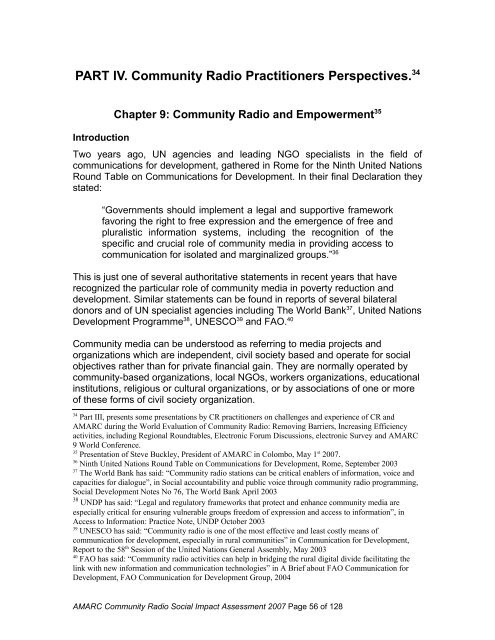Removing Barriers, Increasing Effectiveness - amarc
Removing Barriers, Increasing Effectiveness - amarc
Removing Barriers, Increasing Effectiveness - amarc
Create successful ePaper yourself
Turn your PDF publications into a flip-book with our unique Google optimized e-Paper software.
PART IV. Community Radio Practitioners Perspectives. 34IntroductionChapter 9: Community Radio and Empowerment 35Two years ago, UN agencies and leading NGO specialists in the field ofcommunications for development, gathered in Rome for the Ninth United NationsRound Table on Communications for Development. In their final Declaration theystated:“Governments should implement a legal and supportive frameworkfavoring the right to free expression and the emergence of free andpluralistic information systems, including the recognition of thespecific and crucial role of community media in providing access tocommunication for isolated and marginalized groups.” 36This is just one of several authoritative statements in recent years that haverecognized the particular role of community media in poverty reduction anddevelopment. Similar statements can be found in reports of several bilateraldonors and of UN specialist agencies including The World Bank 37 , United NationsDevelopment Programme 38 , UNESCO 39 and FAO. 40Community media can be understood as referring to media projects andorganizations which are independent, civil society based and operate for socialobjectives rather than for private financial gain. They are normally operated bycommunity-based organizations, local NGOs, workers organizations, educationalinstitutions, religious or cultural organizations, or by associations of one or moreof these forms of civil society organization.34Part III, presents some presentations by CR practitioners on challenges and experience of CR andAMARC during the World Evaluation of Community Radio: <strong>Removing</strong> <strong>Barriers</strong>, <strong>Increasing</strong> Efficiencyactivities, including Regional Roundtables, Electronic Forum Discussions, electronic Survey and AMARC9 World Conference.35Presentation of Steve Buckley, President of AMARC in Colombo, May 1 st 2007.36Ninth United Nations Round Table on Communications for Development, Rome, September 200337The World Bank has said: “Community radio stations can be critical enablers of information, voice andcapacities for dialogue”, in Social accountability and public voice through community radio programming,Social Development Notes No 76, The World Bank April 200338 UNDP has said: “Legal and regulatory frameworks that protect and enhance community media areespecially critical for ensuring vulnerable groups freedom of expression and access to information”, inAccess to Information: Practice Note, UNDP October 200339UNESCO has said: “Community radio is one of the most effective and least costly means ofcommunication for development, especially in rural communities” in Communication for Development,Report to the 58 th Session of the United Nations General Assembly, May 200340FAO has said: “Community radio activities can help in bridging the rural digital divide facilitating thelink with new information and communication technologies” in A Brief about FAO Communication forDevelopment, FAO Communication for Development Group, 2004AMARC Community Radio Social Impact Assessment 2007 Page 56 of 128
















